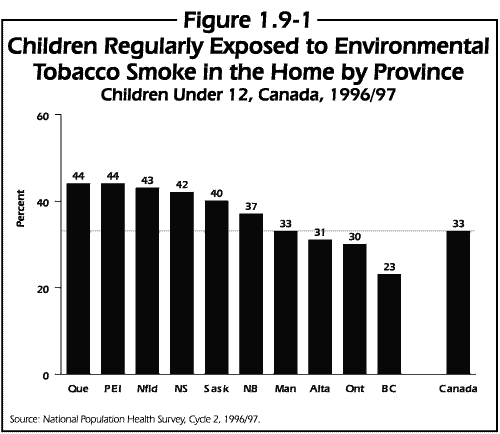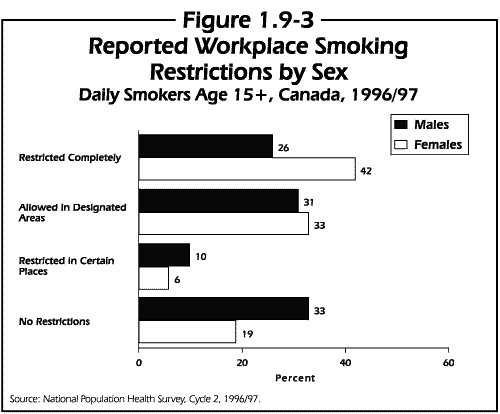Centre for Chronic Disease Prevention and Control
Cancer

Smoking Behaviour of Canadians
Cycle 2, 1996/97 (January 1999, No. 1)
Exposure to Environmental Tobacco Smoke
Home Exposure of Children to Environmental Tobacco Smoke (ETS)
In 1996/97, an estimated 33% of children in Canada under the age of 12 were regularly
exposed to ETS in their home. The percentage varied widely by province (Figure
1.9-1). Exposure of children was lowest in British Columbia, Ontario
and Alberta, and highest in Quebec, Prince Edward Island, Newfoundland, Nova Scotia and Saskatchewan.

Cycle 2 of the National Population Health Survey (NPHS) did not directly assess
concerns about smoking around children in the home. However, respondents were asked whether they agreed or disagreed
that "pregnant women, and others living with them, should not smoke in the home during the pregnancy". This question
asks about concerns both with active smoking by pregnant women and passive smoking within the home. Eighty-nine
percent of smokers and 97% of non-smokers agreed with this statement (Figure
1.9-2). Female current smokers (particularly those over 25) were less
likely to agree than were male current smokers (84% vs. 93% respectively).

Smoking in the Workplace
In 1996/97, 73% of daily smokers reported either a total or partial restriction
on smoking in their workplace. A higher percentage of female smokers than male smokers (81% and 67% respectively)
reported that they worked in a location that restricts smoking, either fully or partially (Figure 1.9-3). This difference between males and females was
seen in all regions of Canada. However, daily smokers of both sexes in Ontario were more likely to report workplace
smoking restrictions than smokers in other regions.

When asked whether non-smokers should have smoke-free work areas, 88% of current
smokers (90% of female and 86% of male smokers) and 95% of non-smokers (of both sexes) agreed (Figure 1.9-2).
Concerns about Environmental Tobacco Smoke
Canadians expressed a high degree of concern about ETS. Although non-smokers
were more likely to express these concerns, they were shared by very substantial proportions of smokers. For example,
non-smokers were more likely than current smokers to answer "yes" when asked, "Do you ever feel the unpleasant
effects from second-hand smoke?" (Figure 1.9-2). Nevertheless, 41% of smokers (35% of male smokers; 48% of female smokers) reported experiencing
the unpleasant effects of environmental tobacco smoke.
When asked whether "smokers should ask permission before smoking in the presence
of others", 94% of non-smokers and 83% of smokers agreed. More female current smokers agreed (87%) than male current
smokers (79%). Agreement with this statement did not vary by age. There was also little variability across regions,
except that Quebec smokers (70%) were much less likely than smokers in other provinces to agree that a smoker should
ask permission before lighting up (percent of smokers agreeing in other regions ranged from 84-91%). Interestingly,
Quebec smokers were more likely than smokers in other regions to report being bothered by ETS (45% in Quebec
vs. 35-40% in other regions).
|
Terminology
- Current smoker - was smoking at the time of the interview, and includes
daily smokers and non-daily smokers (also known as occasional smokers). Smoking status was determined
from the response to the question: "At the present time do you smoke cigarettes daily, occasionally or not at all?"
- Former smoker - was not smoking at the time of the interview, however
answered "YES" to the question: "Have you ever smoked cigarettes at all?" Former daily smokers and former
occasional smokers were then determined by their response to the question: "Have you ever smoked cigarettes
daily?". In Cycle 2, time since quitting was not collected.
- Never smoker - was not smoking at the time of the interview and answered
"NO" to the question: "Have you ever smoked cigarettes at all?"
- Non-smokers - are former smokers and never smokers, combined.
- Prevalence of smoking - the proportion of cigarette smokers in the specified
population.
- Amount smoked - the number of cigarettes smoked per day for daily smokers
only.
- Quitters - those individuals who classified themselves as either "daily"
or "occasional" smokers in 1994/95, and then as "former smokers" in 1996/97.
- Environmental tobacco smoke (ETS) - also known as second-hand smoke.
Exposure to ETS was determined from the response to the question: "Does anyone in this household smoke regularly
inside the house?"
|
|
![]()





